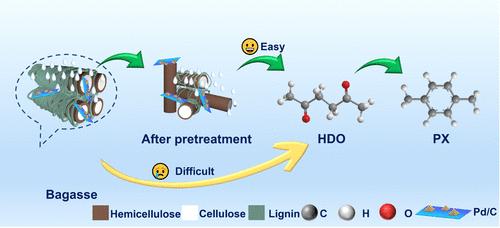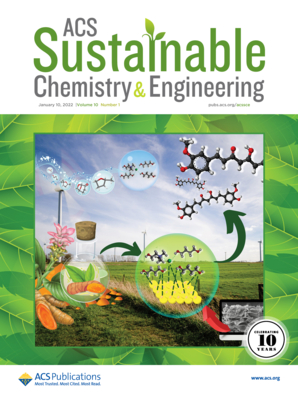Investigation on the Impact of Coexisting Component for the Catalytic Hydrogenolysis of Cellulose in Bagasse to 2,5-Hexanedione
IF 7.1
1区 化学
Q1 CHEMISTRY, MULTIDISCIPLINARY
引用次数: 0
Abstract
Catalytic conversion of cellulose in biomass into 2,5-hexanedione is a significant step for the production of biobased p-xylene (PX), and a precise understanding about the effect of the coexisting hemicellulose and lignin components is extremely essential and desirable, but still severely deficient. Herein, we investigate the above issue by catalytic tests, structural characterizations, and composition analysis. Catalytic tests confirm that the coexisting hemicellulose does not affect cellulose conversion and could be converted into 5-chloro-2-pentanone, while the lignin component plays a detrimental role. Lignin and the oligomers from lignin hydrogenolysis can block the catalytic active sites via deposition due to the strong interaction between lignin and Pd/C catalyst. Meanwhile, there is noncovalent interaction between lignin and cellulose, reducing the accessibility of cellulose to the catalytic active sites including the Pd/C and acidic sites. Basic treatment by NaOH aqueous solution could result in simultaneous removal of lignin and fracture of the biomass structure and hence higher accessibility for the Pd/C catalyst. When the biomass is treated by NaOH with the concentration of 1.0 wt %, the amount of lignin (8.3 wt %) is low enough and the structure is fractured enough to achieve the yield of HDO and DMF comparable to that using sole cellulose as the reactant.

求助全文
约1分钟内获得全文
求助全文
来源期刊

ACS Sustainable Chemistry & Engineering
CHEMISTRY, MULTIDISCIPLINARY-ENGINEERING, CHEMICAL
CiteScore
13.80
自引率
4.80%
发文量
1470
审稿时长
1.7 months
期刊介绍:
ACS Sustainable Chemistry & Engineering is a prestigious weekly peer-reviewed scientific journal published by the American Chemical Society. Dedicated to advancing the principles of green chemistry and green engineering, it covers a wide array of research topics including green chemistry, green engineering, biomass, alternative energy, and life cycle assessment.
The journal welcomes submissions in various formats, including Letters, Articles, Features, and Perspectives (Reviews), that address the challenges of sustainability in the chemical enterprise and contribute to the advancement of sustainable practices. Join us in shaping the future of sustainable chemistry and engineering.
 求助内容:
求助内容: 应助结果提醒方式:
应助结果提醒方式:


